In PART 1 of INSIDE THE BATMAN: The STEVE ENGLEHART INTERVIEWS, we delve into Detective Comics #469…
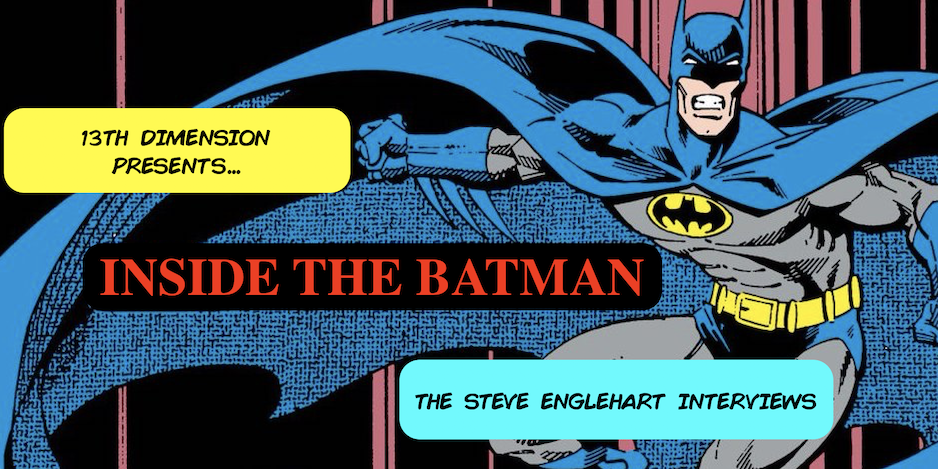
Welcome to INSIDE THE BATMAN: THE STEVE ENGLEHART INTERVIEWS, an issue-by-issue exploration of the greatest Batman story of all time — Steve Englehart and Marshall Rogers’ seminal late ’70s Detective Comics run. The complete story has finally been collected for the first time in hardcover — and in the way Englehart envisioned it — in Tales of the Batman: Steve Englehart. With the book newly released, the time is perfect to go back and look at the story from every conceivable angle. Each weekend for the next couple of months, we’ll be diving into a single chapter of the 8-issue saga, with full commentary by Englehart himself — the most complete analysis of the landmark storyline ever published. For the INDEX of individual entries, click here.

In the PRELUDE to this interview series, Steve Englehart detailed how he landed the gig, what he set out to accomplish, what his overarching thoughts are on Batman and the Joker, the change in art teams from Walt Simonson and Al Milgrom to Marshall Rogers and Terry Austin, how he structured the story and more. Click here to check it out.
But now, we’re on to the first issue of the saga: Detective Comics #469, with art by Simonson and Milgrom, released in February 1977. The issue is broken down into a main story introducing Dr. Phosphorus and his mission to poison Gotham’s water supply (…By Death’s Eerie Light!), and a back-up, The Origin of Dr. Phosphorus — which introduces a corrupt politician named Rupert Thorne.
Dig it.
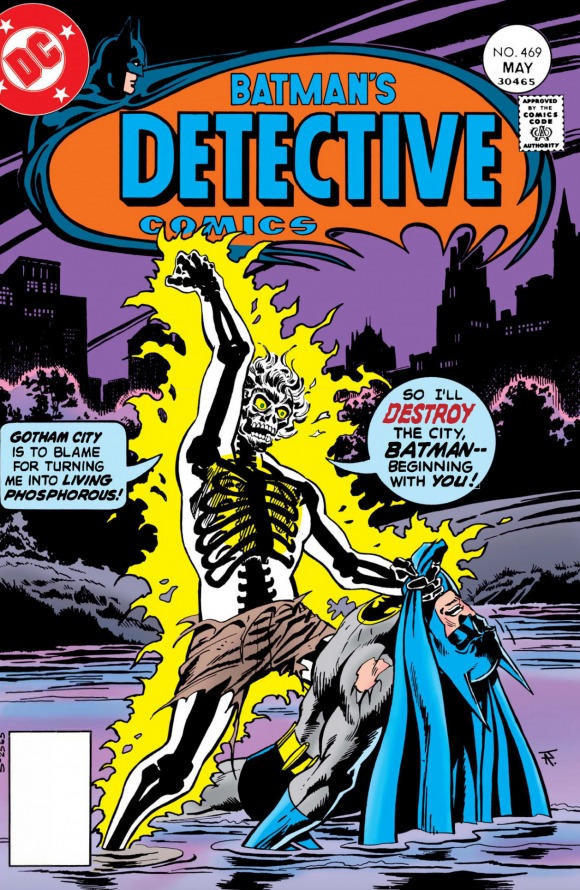
Jim Aparo
Dan Greenfield: What I love about this particular story arc is that you do three things in terms of the characters: You’ve got the classic characters, heroes and villains; characters who you created; and you have characters who are refurbished, basically. You have this mix of three different pots from where you’re getting your characters. So where did Dr. Phosphorus come from to begin with?
Steve Englehart: Well I needed a new villain. I told you all the stuff I put together before, but I wasn’t there just to like, recycle everything.
When I went back and looked at the ’40s issues — again that’s the first thing I did, I wanted to look at the ’40s issues. So I went to DC and they had (and probably still do) a library where they have everything they had ever published, hard-bound, volume by volume, and I said I want to look at the first couple years of Detective Comics.
People were kind of like, “Really? Nobody ever does that. Why would you want to do that?” Because I want to see what’s there! So they Xeroxed everything for me from the books. I was going home to California so I mean if I’d been in New York maybe they would have just loaned me the books or maybe not, I don’t know, but I had Xeroxes of the first year or two of Detective Comics, the Batman stories.
There I discovered Hugo Strange and thought OK, I’m going back to the ’40s to get the pulp atmosphere. The Joker’s already there, and the Penguin, but Hugo Strange is kind of a weird guy, and that would be kind of fun to pull that and make that clear that he came from the ’40s.
But again, me personally, I couldn’t just go and say, well here’s something that happened and here’s something that happened and here’s something that happened and put it together. I needed to have new villains.
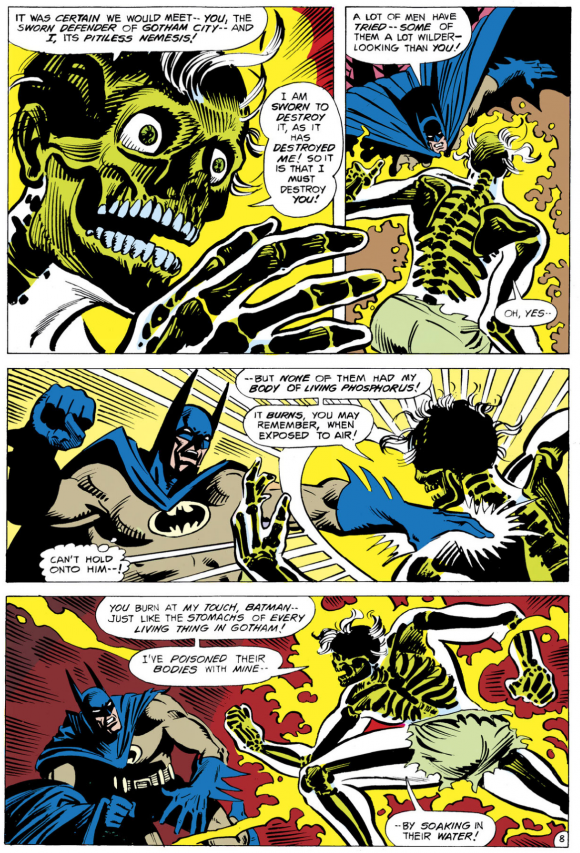
Dr. Phosphorus — I mean I just got through saying that Denny (O’Neil) and Neal (Adams)’s Joker’s Five-Way Revenge! (in Batman #251) wasn’t really a classic Joker story because it was about pollution. Well, what am I doing, right? That’s the era we were all in. So I’m doing a guy who wants to poison the water of Gotham City with his chemical stuff, but he’s obviously pulpier, with his skeleton showing through his body and all this kind of stuff. So I’m not averse to being part of the gestalt that I’m living in at the time. Anyway, so a new villain to start things off, but an old vibe, hopefully, and a deeper Batman.
In those days, Detective Comics had like an 11-page opening story with about a 6-page secondary story. The secondary story was usually a Robin story or an Elongated Man story or something like that. I said, I got a lot of story to tell here and I’ve only got seven issues*, so… can I have the back-up story and I’ll make it the origin of Dr. Phosphorus so it’s got some patina of being different? In the process there we meet Rupert Thorne. We meet the corrupt Gotham City Council.
(* The story was planned as seven issues but later expanded to eight. — Dan)
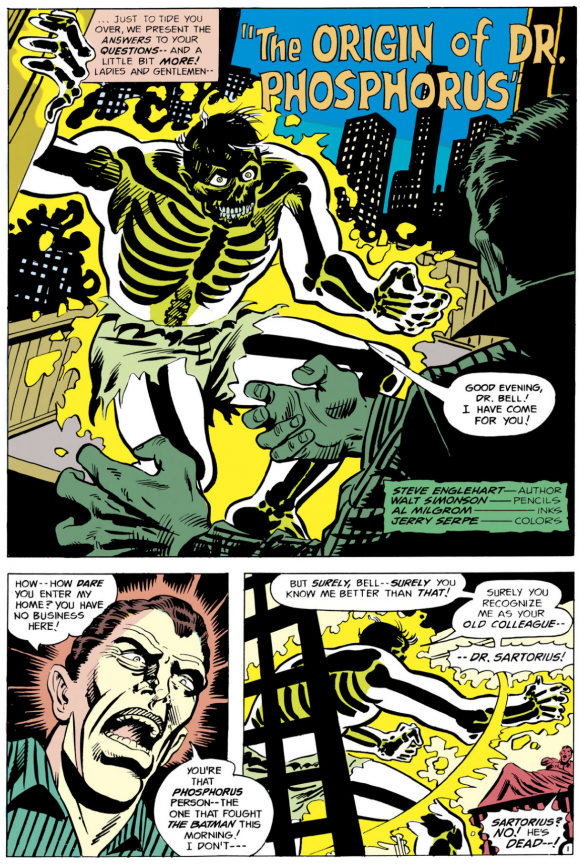
It seemed to me that… you know, I don’t see Gotham as a hell hole. I mean if Batman and Commissioner Gordon are running their shows, it’s not like the whole place has gone to hell, but it certainly wouldn’t be surprising to have some corrupt city officials who had their own ideas of which way Gotham City was supposed to go. So here comes Boss Thorne and the government.
We get the origin of Dr. Phosphorus and we set up almost everything — we still haven’t met Silver St. Cloud yet. The first issue accomplished a lot of things.
Dan: The first issue sets up Dr. Phosphorus, the reason for Thorne to turn on Batman, it sets up all of the basic themes of where we’re going to go. Now Thorne I assume was kind of a pastiche of Boss Tweed and Tammany Hall and all of that. That was always the vibe I got.
Steve: Yeah, I mean I’m not from New York but I know who those guys are and I know the history of New York to that extent, so yeah. Boss Tweed, Tammany Hall, that was well known, so here was — again it’s not like Gotham City or New York had been lily pure forever and this was going to come out of nowhere — and I thought, I’d done Captain America vs. the American government and as it turns out that’s a trope that’s been continued to be played for 50 years. It seemed to me, without knowing that, well this is a good way to set up your hero to have the authorities trying to shut him down, and I thought if you were corrupt and a criminal in Gotham City you would want Batman to knock it off, so insofar as you could affect that, that was all there.

Dan: It also mimicked those early Batman stories where he was basically being chased by the cops while he was chasing the criminals.
Steve: Yeah, there’s only so much of that that I can stand. I tend to believe in the heroes. That’s why I did what I did. So the idea that the guy would have to spend all of his time looking over his shoulder never appealed to me particularly. Again he’s the fuckin’ Batman, right? So he’s not gonna just let this go on. He’s going to solve that problem some way or another. So that gives me something to work with, with his personality and his situation.
That’s what I say about organic, that you do one thing and then that leads to something, and then you deal with that and then that leads to something.
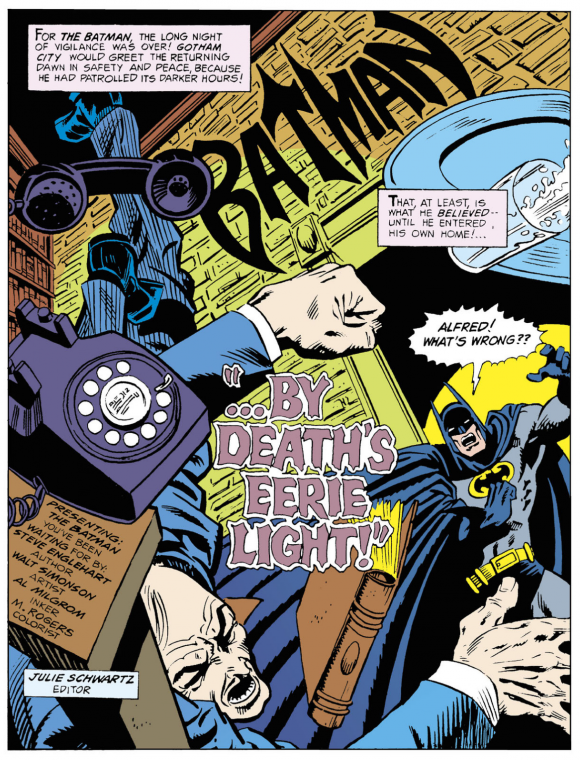
Dan: I have one last question about the first issue, which I only noticed when I reread it in preparation for this interview. I noticed on the very first page on the credit box it says, “Presenting the Batman you’ve been waiting for, by Steve Englehart.” Was that your idea, or was that (editor) Julie Schwartz who put that in there?
Steve: No that’s me, that’s Marvel. That’s Marvel’s stuff, right? But the thing was, and I will say this, I mean, back when Marvel was the House of Ideas they gave Stan (Lee) shit for saying things like that. At the same time, he was delivering the goods, right?
It was later editors I know who would say “the greatest story ever from the House of Ideas,” and it wasn’t. We’d moved on from there, and these guys weren’t as good as the guys… But I felt, I trust myself to deliver the goods, and I figured if you’re going to deliver the goods then you can bullshit about it. You can say stuff like that.
So, and again, I’m trying to sell this book for DC, I’m over there, what can I do that I know how to do that would be useful to them? The first of my many mistakes trusting, trying to help DC out. That was part of the thing. And (publisher) Jenette (Kahn) specifically said, do for the Justice League what you did for the Avengers. I was trying to give it that old, “Here’s the most fun you’re gonna have in the next hour” kind of thing. I felt it was incumbent on me to try to deliver that — not just to say it. But if I felt that I was delivering it, then I would say it, so there’s that.
—
NEXT: DETECTIVE COMICS #470 — The Origin of SILVER ST. CLOUD — and BATMAN’s Sex Life. Click here.
—
MORE
— INSIDE THE BATMAN: THE STEVE ENGLEHART INTERVIEWS Complete INDEX. Click here.
— PRELUDE: STEVE ENGLEHART: ‘I Wanted to Do the Definitive BATMAN’. Click here.

June 27, 2020
Great interview. I remember these issues on the spinners. I’m surprised by how much Walt’s artwork doesn’t strike me as his. And, hearing Steve talk about the genesis of his story, just makes me miss the character of the ’70s that much more. Damn you, Crisis!
June 27, 2020
I’m sure Steve or Dan will get into it but Walt only did very loose breakdowns and Al Milgrom finished them. I like both artists but I don’t love the results from working like this.
June 27, 2020
We actually got into that in the prelude: https://13thdimension.com/steve-englehart-i-wanted-to-do-the-definitive-batman/
June 27, 2020
Steve said that Walt did just layouts. Milgrom the pencils & ink .
June 28, 2020
This is a pretty impressive first part of your interview with Steve Englehart. I’ll be looking forward to more parts.